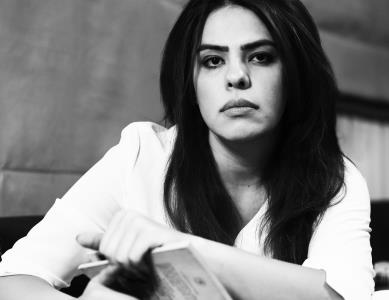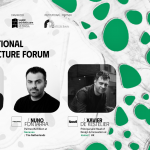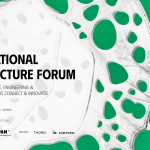In dialogue Habibeh Madjdabadi about “Designing the profile of the future architect”
Andreea Movila: We are talking with HABIBEH MADJDABADI, a guest of SHARE conference Tirana 2018. She is one of the outstanding architects of the younger generation in Iran, her realizations revealing a meticulous and continuous research about the new possibilities of using contemporary artistic approach and techniques in a local context.
I would start asking you how is the profession for women architects in Iran? How did it feel from inside?
HABIBEH MADJDABADI:
Architecture belongs to everybody, but everybody cannot be a Client for architecture. In Iran, in most cases, the clients of architecture are among elite and a female architect is to some extent accepted by this level of the society. But it is also true that women still work in the niche market and most of the projects are entrusted to men.
I personally have never experienced a noticeable problem dealing with private clients, organizations or with the people involved in the process of realization n my profession I had to deal with different kinds of clients such as general managers of the banks, ambassadors, CFO of the international companies, managers of Cultural Heritage Organization, international engineering companies and ambitious private customers with cultural interests.
I am working with STATBYGG on the Norwegian Embassy project. The company is responsible for the public buildings, based in Oslo. The Top Manager of this company, is responsible of the department taking care of the embassies and all the project managers were women, so there was no gender-bias in that instance.
Anyhow when you adhere to your principles, when you take on different types of challenging projects and you try to be a creative designer and when you do not follow the client’s personal tastes and fleeting desires, then your customer circle becomes limited and you can only work with selected clients, who are ready to face the design and construction challenges.
A.M: What is it like working in avant-garde?
H.M: (laughs) it’s a bit scary for new clients who see our previous projects, sometimes they think that they are going to face a big hassle.
I like the unpredictable quality of architecture, every new project is a new opportunity for research.
Obviously, there are also difficulties in doing experimental work and avoiding common stereotypes, but at the end of the day, our reward is the pleasure of overcoming the problems.
Here, I would like to make a reference to the creative advertisement written for Cadillac in 1915, titled: The Penalty of leadership. The revolutionary ad was written by Theodore F. MacManus When the company was temporarily out of competition as a result of taking leadership risks and testing new engines. The ad states that if you want to be avant-garde In art, in literature, in music, in industry, the reward and the punishment are always the same. The reward is widespread recognition; the punishment, fierce denial and detraction. (1)
I think this ad is a manifest for architects and anyone doing creative work:
A.M: So, as an outstanding architect for the younger generation –
H.M: If we consider a forty years old architect young (laughs).
A.M: Almost fifteen years of professional practice…
H.M: Yes, about 15 years or more, I graduated in 2002 and right away, I won a competition with Cultural Heritage Organization in Iran. I had to start my own office to make the contract and to do the job. Then, I had some projects with the same organization and, afterward, I participated in various competitions which helped me gain experience at the beginning of my career.
A.M: Therefore, entering competitions could bring to young architects a real chance to make their entry. Well, regarding our topic, I would like to ask you what you think that are the most relevant qualities that should outline the profile of the future architect.
H.M: the future doesn’t always mean novelty and going forward. Through History Progress has not been linear, like a straight line. It has ups and downs and it is most likely a dashed line, where after a while you realize there are blank spaces left behind. To think of the future perspective, sometimes you need to go back to the past and learn about the past. Unfortunately, our progress is most often one-dimensional. We get something while sacrificing a lot of other things. Therefore, we need to go back and reinstate things that have been put aside for no reason.
As an example, during the industrial era, people were fascinated by machines and machinery products. At that time increasing the production of such products was considered as a great achievement. Today, we have come to the realization that many qualities of living have been sacrificed through industrialization now we are seeking those qualities again in craftsmanship and handmade objects.
In the modern era, influenced by the famous motto “architecture as a machine for living, architects have reduced human needs to those physical. I think today and in the future, we should consider spiritual dimension of life. The task of an architect is to be inspiring and to feed the human spirit through meaningful spaces.
We should not disregard our social role and responsibility. The majority of people belong to middle-class or even live in the conditions of poverty. They cannot afford the fee of an architect or expensive materials and technologies. So, we are here to find a solution for them. To help the middle class enjoy high quality and architecturally designed spaces, to encourage them to get help from architects.
Architecture is not a luxurious fantasy and it does not belong to the certain class of the society. This was our concern in designing the “40 knots house” which is a low budget residential building in a middle-class area of Tehran. The project was nominated for the Aga Khan Award for architecture in 2016.The House of 40 Knots is located in a lower middle-class neighborhood, where the people can hardly hire an architect. The owner didn’t have sufficient budget to pay appropriate architecture design and supervision services. we accepted the challenge because we believe the real art belongs to everyone, not simply the wealthy.
In order to reduce the construction costs, we decided to use bricks as the main construction material. Bricks are ancient and modern at the same time, they belong to earth, tradition and to this land. Iran is the land of craftsmen par excellence and still, here the manpower is relatively inexpensive. In order to valorize this potentiality, we decided to conceive the building as a handicraft. We didn’t have design development and detailed design in our scope of services, we replaced the technical drawings package with the oral instructions given gradually to the workers. Our solution was translating architectural drawings into text
A.M: So you translated the architectural drawings to their language?
H.M: – we translated to text.
A.M: Text?!?
H.M: the method of communicating the plan to the workers was inspired by the method in traditional carpet workshops. For making a carpet there are 3 basic characters: carpet designer, the man who translates the drawings in oral instructions and the wavers who are not aware of the final result of their work, but execute different knots and colors each moment they receive a simple instruction. the same system is used for creating a very complex work by the hand of inexperienced workers using recited instructions instead of drawings. A certain freedom has been left to the workers for fixing bricks.
A.M: So, a virtue for the young architects to look for would be the capacity to address specifically every situation and be patient.
H.M: Yes, we need patience. Every new project encompasses its idea within it, the project itself suggests what to do and what not to do. The right solution lies within the project conditions: context, time, sociocultural issues, budget, available materials, and techniques, etc. The role of the architect is to recognize priorities and to understand which aspects of the project can inspire the main architectural solutions: ideas that can gather and solve all the problems in a unique and clever solution. A creative reaction to the problems outlines the architectural ideas
A.M: So, it is still possible for the architects today to do craft art?
H.M: In Iran, it is still possible. the hourly wage of workers is not so high and not higher than using advanced technology.
A.M: What future trends do you envision for the field?
H.M: As I said before, sometimes, we need to look back. There was a time when architects used artificial materials extensively, nowadays, they tend to turn to natural materials and revive local techniques. Previous approaches have been questioned. Now people have begun doubting technology and unlimited linear progress. There was a time that plastic bags were very common. Now, we are using again paper bags. This suggests, that perhaps the most ideal solutions can be found in history.
A.M: What is your definition of architecture? Or, let’s say, what is your professional statement?
H.M:
To start a new design I believe as an artist you should start from flying very high, thinking of the impossible, the most surreal imaginations, and the most unconventional solutions. I, personally like to begin from there, if I start from the highest I can fly then I can make the design land on earth, then I would be able to make possible the impossible, to make real from surreal. But if I start from known standards, then I’ll not be able to fly high and pass my limitations, then I can’t cross my borders…
So my approach to architecture is from an artistic point of view. I am coming from a country with a long history of art and craftsmanship. These days I’m more focused on valorizing artisan approximation in design and construction process to make architecture more human. Involving workers in the process of creating architecture as an art piece which belongs to all.
A.M: What was the best advice you’ve received during your career?
H.M: I like to make a reference to a quote from the French designer Phillippe Starck. I always keep the lesson that he has taught me in mind when I start a new project. He says that when you decide to design a faucet, you should think of water and not the faucet. So, you should go back to the roots to solve the problem… in a new way, thinking out of cliché, out of the box.
A.M. You are collaborating with Memar Magazine as a member of the editorial board. Why do you believe is important for architects to engage in parallel with the field of architectural theory?
H.M: I’ve done the architecture practice and writing experience in parallel from scratch, I do not see that as independent of one another. If you do not know how to analyze and critique architecture, then you cannot think critically about your own work.
A.M. To conclude in the same manner we have started…What piece of advice do you have for women entering the field of architecture?
H.M: I believe the obstacles female architects face are more internal than external barriers. During my career, I’ve seen a lot of female architects, who, despite their abilities, at best, think of themselves as the second best person and always imagine their capabilities as inferior to men’s. Sometimes they consciously choose to be number two I believe that women should be confident and not to be afraid of taking more dominant roles.
And of course, this should be considered that taking this role has consequences like accepting responsibility, making decisions, risking, making mistakes, and paying for mistakes. I think the next generation will leave behind the male-dominated minds and we will all see many successful female architects.
A.M: Thank you so much for your time!
……………………………………………………………………………………………………….
- the text of Cadillac’s iconic ad, The Penalty of Leadership:
“In every field of human endeavor, he that is first must perpetually live in the white light of publicity. Whether the leadership is vested in a man or in a manufactured product, emulation and envy are ever at work. In art, in literature, in music, in industry, the reward and the punishment are always the same. The reward is widespread recognition; the punishment, fierce denial and detraction. When a man’s work becomes a standard for the whole world, it also becomes a target for the shafts of the envious few. If his work is mediocre, he will be left severely alone – if he achieves a masterpiece, it will set a million tongues a-wagging. Jealousy does not protrude its forked tongue at the artist who produces a commonplace painting. Whatsoever you write, or paint, or play, or sing, or build, no one will strive to surpass or to slander you unless your work is stamped with the seal of genius. Long, long after a great work or a good work has been done, those who are disappointed or envious, continue to cry out that it cannot be done. Spiteful little voices in the domain of art were raised against our own Whistler as amount back, long after the big world had acclaimed him its greatest artistic genius. Multitudes flocked to Bayreuth to worship at the musical shrine of Wagner, while the little group of those whom he had dethroned and displaced argued angrily that he was no musician at all. The little world continued to protest that Fulton could never build a steamboat, while the big world flocked to the river banks to see his boat steam by. The leader is assailed because he is a leader, and the effort to equal him is merely added proof of that leadership. Failing to equal or to excel, the follower seeks to depreciate and to destroy – but only confirms once more the superiority of that which he strives to supplant. There is nothing new in this. It is as old as the world and as old as human passions – envy, fear, greed, ambition, and the desire to surpass. And it all avails nothing. If the leader truly leads, he remains – the leader. Master-poet, master-painter, master-workman, each in his turn is assailed, and each holds his laurels through the ages. That which is good or great makes itself known, no matter how loud the clamor of denial. That which deserves to live – lives.”
…………………………………………………………………………………………….
The editorial project “Designing the Profile of the Future Architect” will be addressed over the course of a year through personal contributions, interviews, and discussions sampled from the 10 locations where ABplus Events organizes conferences, reflecting afterward in a publication which will be released next year at SHARE Bucharest, 2018.



